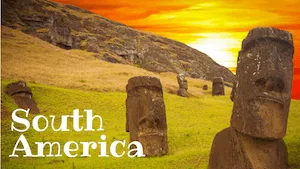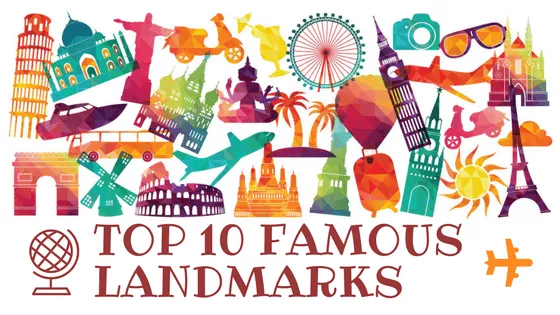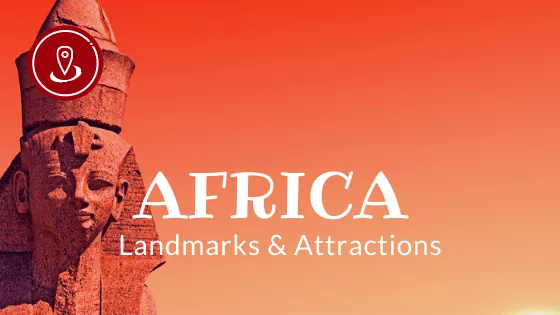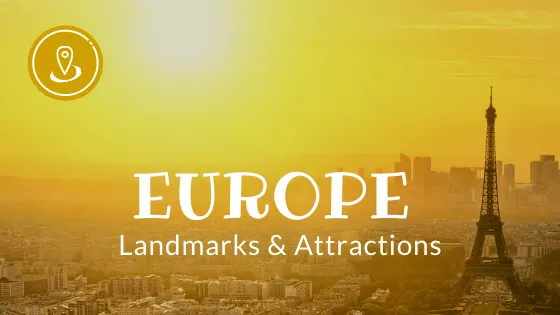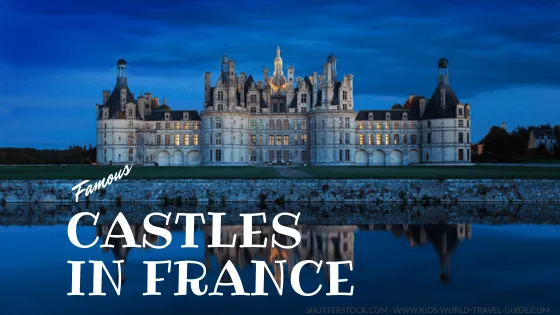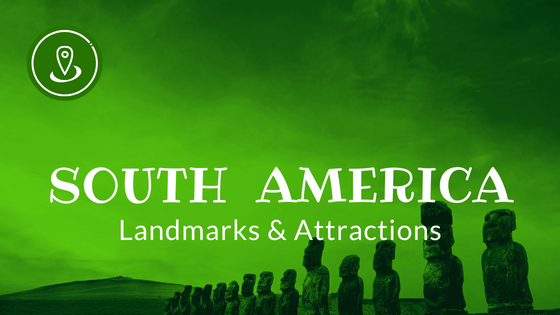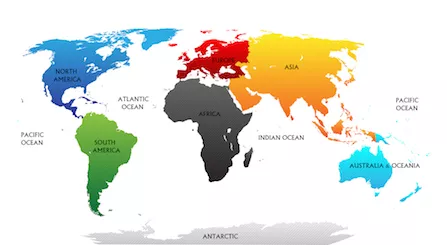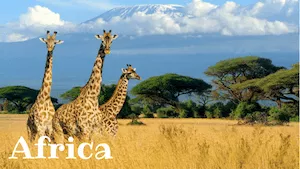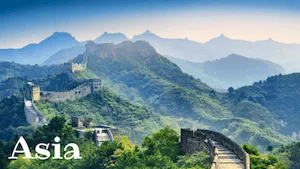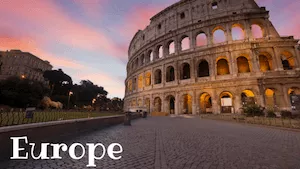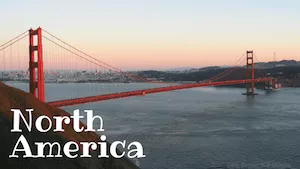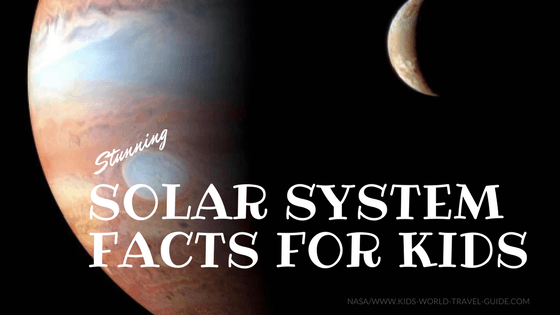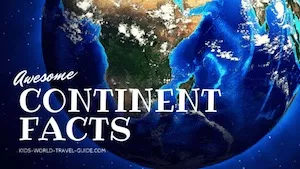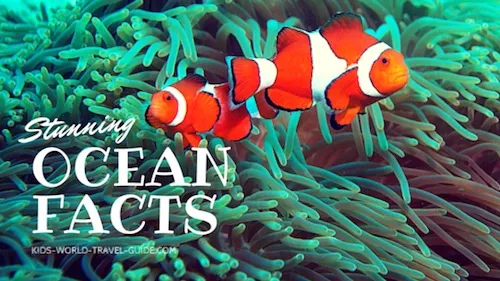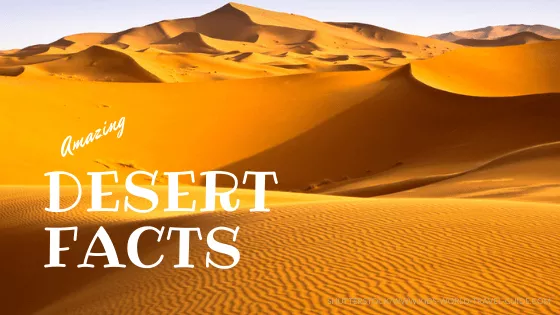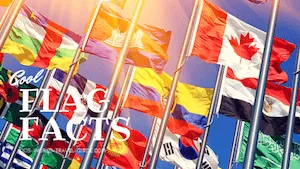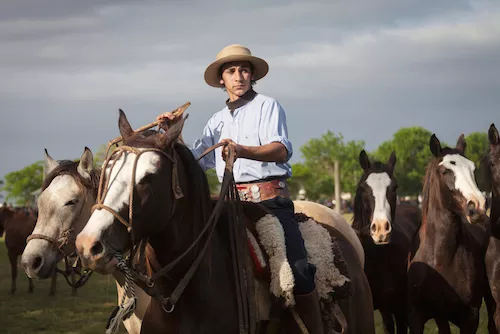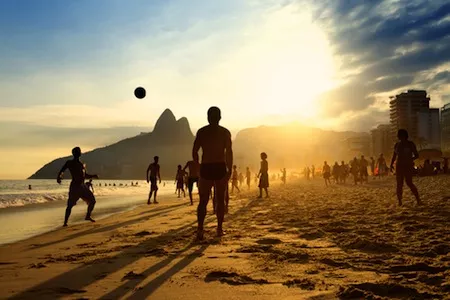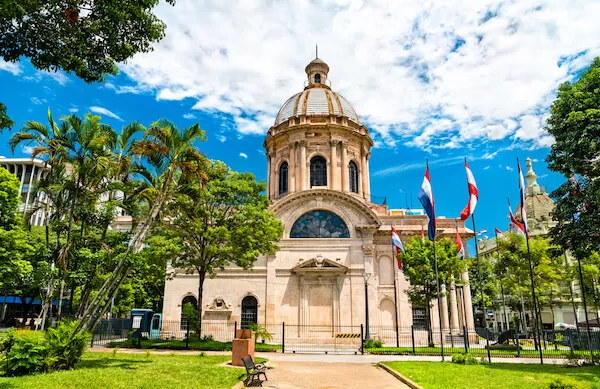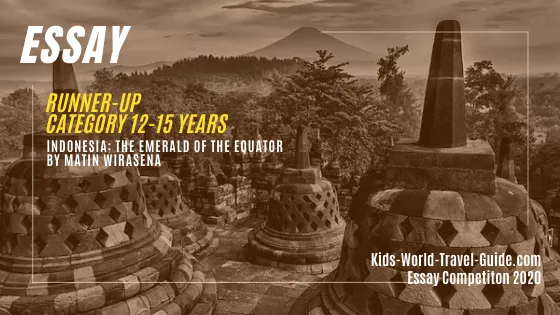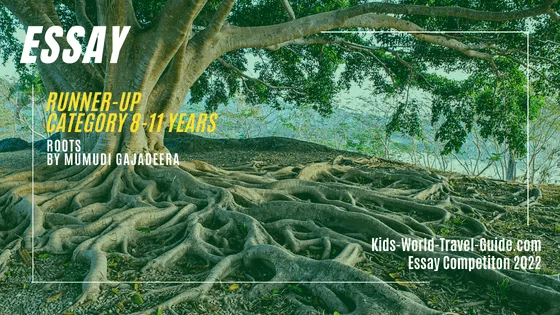Landmarks in south America
Which are the famous and amazing landmarks in South America?
The natural landmarks and natural features as well as man-made attractions in South America that we show below are well known for their unique locations, awe-inspiring features or outstanding design and architecture.
Which of the South American landmarks below do you recognise? Can you name these landmarks and attractions in South America and locate them on a map?
 Landmarks in South America - impressions
Landmarks in South America - impressionsSouth America houses 12 independent countries and there is a vast number of attractions and landmarks on the continent.
There are over 70 UNESCO world heritage sites in South America with Brazil having the most UNESCO sites in South America. Here are 20 of the most well-known monuments and famous landmarks on the South American continent.
Top 20 Landmarks in South America
The following landmarks in South America were chosen as they are attract a huge number of visitors to the region each year. All these landmarks are major tourist attractions in South America and you will love to explore these inspiring sites.
1 | Machu Picchu in Peru| Landmarks in South America
The ancient ruins of Machu Picchu attract almost half a million visitors every year. This UNESCO world heritage site stands on the slopes of the Andes mountains in the deep jungle of the tropical rainforest of Peru.
 Machu Picchu
Machu PicchuThe ancient Inca site is located in Peru at a high elevation of 2,430 m/ 7,972 ft above sea level.
The name Machu Picchu originates from the Quechua language and means "old mountain".
There are about 200 structures of the former citadel with remainders of walls, terraces and temples as well as a sacred stone with points that shows the equinoxes, which means the exact time the sun crosses the equator twice a year. The sun sets over the stone without throwing any shadow. More info about this landmark.
2 | Amazon River Valley in Brazil
The Amazon river is the world's second longest river and the rainforests of the Amazon river basin are known as the "lung of the earth".
 Amazon
AmazonThe Amazon river itself is about 6,400 km/ 4,000 miles long. The river flows through Peru, Colombia and enters the Atlantic Ocean in Brazil.
Brazil holds the world's largest freshwater reserves and is the most biodiverse country in the world.
Here more great Amazon Rainforest Facts
3 | Sugarloaf Mountain in Brazil
Sugarloaf mountain's shape is a well known attraction of Rio de Janeiro, but is not the only easily recognisable landmark of Brazil. In Rio de Janeiro, you also find the famous statue of Christ the Redeemer as seen here in the foreground.
 Rio de Janeiro
Rio de JaneiroThe Christ The Redeemer statue is located on Corcovado mountain overlooking Rio de Janeiro. The 30 m/ 98 ft high statue was created by an international team of artists, two engineers from Brazil and France and two sculptors from Romania and France. The sculpture was finished in 1931 and is a famous landmark ever since.
Sugarloaf mountain has received its name from its shape that resembled a traditional cone, which is referred to as sugarloaf - a shape that was already popular in the 16th century.
Sugarcane was one of the main trade products when the Portuguese colonialists arrived in the country. For easier transport of refined sugar by ship, the sugar was filled into conical clay forms, the so-called sugar loaves.
Read our Brazil Facts for Kids here.
4 | Cathedral of Brasília in Brazil
Another easily recognisable landmark of South America is the Roman Catholic Cathedral in Brasília, the capital city of Brazil.
 Brasilia cathedral - image by Robert Napiorkowski
Brasilia cathedral - image by Robert NapiorkowskiThe modern building was designed by Brazilian architect Oscar Niemeyer and completed in 1970.
The unique shape is created with 16 columns and the iconic religious building has a colourful stained glass ceiling. The cathedral can hold up to 4,000 people.
It is said that over one million people visit the Cathedral of Brasília every year. About two thirds of the Brazilians are Roman Catholics and thus Brazil is often referred to as the largest Roman Catholic country in the world.
5 | Mendoza Wine Valley | Argentina Landmarks in South America
The Mendoza Wine Valley is unique for its stunning scenic location in Argentina with the vineyards at the foothills of the Andes mountain peaks. The Andes are the continent's longest mountain range.
 Mendoza wine valley with snowy Andes in the background
Mendoza wine valley with snowy Andes in the backgroundThe Mendoza valley is the largest wine producing region of South America and internationally recognised as the wine capital of South America.
There are about 800 vineyards in the Mendoza valley. Some of the Medoza vineyards are amongst the world's highest as they are located at elevations of up to 1,520 m/ 5,000 ft.
6 | Galapagos island in Ecuador | Landmarks in South America
The Galapagos islands of Ecuador are located in the Pacific Ocean about 1,000 km/ 600 miles off the country's coastline.
 Galapagos
GalapagosTurquoise blue waters, volcanic rock, pristine sandy beaches and the many rare animal species that live here, make the Galapagos an outstanding location on the South American continent.
Ecuador is one of the 17 megadiverse countries and the Galapagos islands are often said to house one of the last unique wildlife zones in the world.
The islands are home to marine iguanas, giant tortoises, blue-footed boobies and some other species that are not found anywhere else in the world.
About 225,000 travellers visit the Galapagos islands every year.
Read our Facts about Megadiverse Countries here.
7 | Atacama Desert | Chile
Landmarks in South America
The Atacama desert is the only true hot desert in the world but often referred to as the second driest after Antarctica.
 Moon Valley in Atacama desert
Moon Valley in Atacama desertDue to the dry air, cloudless sky and high altitude and remoteness the desert is used for astronomical observations. There is no light pollution as in populated areas and thus many telescopes have been placed here by the international scientific community.
The world's largest 'extremely large telescope' is currently being constructed on Cerro Amazones mountain in northern Chile. The 'Very Large Telescope' (VLT) is already operated by the European Southern Observatory (ESO).
8 | Angel Falls in Venezuela
Landmarks in South America
The Angel Falls in central Venezuela are the highest waterfalls in the world. The waterfall called Salto Angel in Spanish is 979 m/ 3,212 ft high.
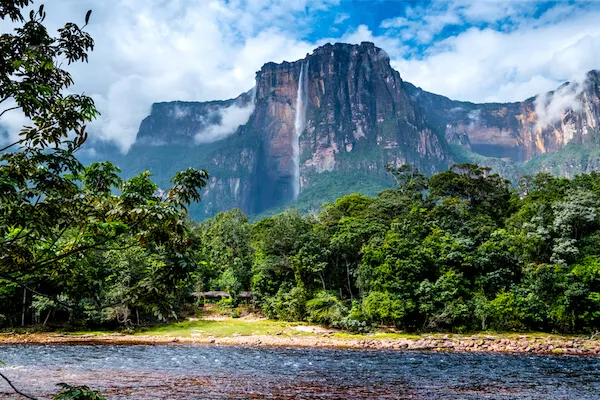 Angel Falls in Venezuela
Angel Falls in VenezuelaThe highest drop from the Ayan mountain is 807 m/ 2,648 ft high. Ayan or Aúyan is a tepui or mountain with a flat top. Tepui are some of the oldest geological formations in the world.
The waterfalls are difficult to reach as they are located in the middle of deep jungle in Canaima National Park.
The world's tallest tepui is Mount Roraima, which is also located in Venezuela, at the border to Brazil and Guyana. The highest point of Mount Roraima's flat top is at an elevation of 2,810 m/ 9,220 ft above sea level.
9 | Lake Titicaca in Bolivia/ Peru
Lake Titicaca is the largest freshwater lake in South America and shared by Bolivia and Peru.
 Floating village on Lake Titicaca
Floating village on Lake TiticacaOften also referred to as the highest lake in South America, Lake Titicaca is located on the Altiplano of the Andes mountains.
The lake is known for the floating islands of the Uros people. The islands are made with sedges or grasses, that grow on the banks of the lake.
10 | Torres del Paine | Chile
- Landmarks in South America
The scenic mountain peaks of the Cordillera Paine in Torres del Paine National Park in Chile are some of the most well-known mountain peaks in the world.
 Torres del Paine National Park
Torres del Paine National ParkThe iconic three towers or peaks of the Paine are of yellow coloured granite and are over 2,884 m/ 9,462 ft high.
The national park in Patagonia attracts about 250,000 visitors every year.
11 | Easter Island |Chile
The Easter Island or Rapa Nui as named by the native people is famous for the magnificent huge statues called moais.
 Moais
MoaisThe Easter Island is a volcanic island located in the Pacific Ocean far off the Chilean coast. Strictly speaking the island belongs to Oceania, but we list it here as part of the South American country Chile.
About 900 large stone statues and over 300 ceremonial platforms are located all over Easter Island.
The name Rapa Nui comes from the indigenous name for the people of the Easter Island. The Rapa Nui people call the island tepito or tehenua, which means 'navel of the world'.
Rapanui is the most remote inhabited island of the world. Only about 7,000 people live on the island that is located at a distance of about 3,500 km/ 2,170 miles from continental Chile.
12 | Nazca Lines in Peru
The Nazca Lines are so called geoglyphs, lines drawn into the soil.
The huge drawings that are as big in area as several football fields were created by the ancient people called the Nazca people, who lived in the area more than a thousand years ago. In fact, the drawings are so big that they can only be fully seen from an airplane or a helicopter.
The giant pictures were created by removing the reddish-brown iron oxide-coated pebbles on the surface, revealing the light-colored earth underneath. The designs include various shapes such as geometric patterns, plants or even animals like spiders, monkeys or birds.

The Nazca people are said to have created these lines for religious or ceremonial purposes but the full background remains a mystery.
Read our Peru Facts for Kids here.
13 | "Middle of the World" in Ecuador
The Middle of the World or Mitad del Mundo monument is placed on the exact location of the equator. The landmark is near Quito in Ecuador and refers to the natural landmark of the equator!

The equator is an imaginary line dividing the planet into a northern and southern hemisphere. This monument is thus standing at 0 degrees latitude. Here you can actually stand on both hemispheres!
The monument is located in a complex that also includes a museum about the indigenous cultures of the region where you can learn about the country's culture and history.
Read our Ecuador Facts for Kids here.
14 | Ojos de Salado in Chile
Landmarks in South America
The Ojos de Salado is the highest point in the Andes mountain range and in Chile. This natural landmark in South America is the highest volcano on Earth and the second-highest peak in the Southern Hemisphere.
This volcano is part of the Central Volcanic Zone of the Andes and the summit reaches 6,893 m/ 22,615 ft. second-highest peak in the Southern Hemisphere.
Ojos del Salado is a stratovolcano, which means it is a tall, conical volcano composed of layers of hardened lava, volcanic ash, and other volcanic rocks.
 Ojos de Salado
Ojos de SaladoThe crater lake on its summit is often frozen due to the extreme high-altitude conditions. The Ojos de Salado is usually referred to as Nevado Ojos de Salado. Nevado means "snowy" and refers to the snow covered peak. The volcano is dormant and lies at the border between Chile and Argentina.
15 | Cotopaxi in Ecuador
Cotopaxi is a snow covered and cone-shaped volcano and one of the highest active volcanoes on Earth. The tall volcano stands at about 5,897 m/ 19,347 ft above sea level.
 Cotopaxi
CotopaxiThe volcano is located in a national park called Cotopaxi National Park where you can see llamas, unique birds, and other cool wildlife.
People from all over the world come to challenge themselves by reaching the top of this famous volcanic mountain. About 200,000 people visit the national park every year!
16 | Gran Torre de Santiago in Chile
The Gran Torre Santiago skyscraper in the capital city of Chile is the highest building in South America.
 Gran Torre in Santiago
Gran Torre in SantiagoThe building is 62-storeys high houses one of the largest shopping malls of the continent, the Costanera Center. The building of the Gran Torre was finished in 2013 and measures 300 m/ 984 ft in hight.
The observation deck Sky Costanera grants visitors a 360° view of the city of Santiago de Chile and surrounding region.
Read our Chile Facts for Kids here.
17 | Salar de Uyuni in Bolivia
The world's largest salt flat is located on the Altiplano of the Andes mountains in southwestern Bolivia. The vast area formed on prehistoric lakes on an elevation of 3,656 m/ 11,995 ft above sea level.
 Salt flat - Salar de Uyuni
Salt flat - Salar de UyuniThe salt pan is almost as large as the island of Jamaica or larger than the US state of Delaware.
There are many layers of salt up to the depth of 10 m/ that are covered by sediments. Thin layers of water cover the surface of the salt flat that on a calm and clear day resembles the world's largest mirror! The mirror effect of the Salar de Uyuni is most visible during the months of March and April.
Beneath the salt crust, the water contains the world's largest deposits of lithium, a metal that is used extensively in various components of laptops, computers, e-cars and phones.
Read our Bolivia Facts for Kids here.
18 | Perito Moreno Glacier in Argentina | South America Landmarks
The best known attraction in Patagonia is the massive ice field of the Perito Moreno glacier. The toe of the glacier is Lake Argentine, locally called Lago Argentino, which is Argentine's largest freshwater lake.
 Perito Moreno Glacier
Perito Moreno GlacierLocated in the Los Glaciares National Park at the border between Argentina and Chile, Perito Moreno glacier belongs to an ice field that includes 48 glaciers.
Perito Moreno glacier houses the world's third largest fresh water reserve - only the Antarctic and Greenland icefields store more fresh water.
The ice field is about 4.8 km/ 3 miles wide and 30 km/ 19 miles long. It stands about 74 m/ 240 ft tall above water and in some parts ice is as deep as 700 m/ 2,297 ft.
Perito Moreno glacier is one of the very few glaciers that do not shrink due to global warning but grows, however, the reason is not completely understood even by scientists.
19 | Iguazu Falls in Argentina
The Iguazu Falls, also spells Iguaçu Falls, are known as the largest waterfall systems in the world.
 Iguazu Falls
Iguazu FallsThe falls are located at the border of Argentine and Brazil, where almost all of Iguazu river basin (95%) is located and the river originates. Most of the waterfalls and jumps, however, are located on the Argentine side.
The water flows and falls over two steps and most of the water then collects in a deep canyon, the Devil's Throat canyon. The Argentina-Brazil border runs through this canyon.
The edge is of the waterfalls is about 2.7 km/ 1.7 miles long and there are up to 300 smaller waterfalls along that edge. The longest drop is about 82 m/ 269 ft high. The Iguaçu waterfall curtain is broken up by many islands and a stretch of about 900 m/ 2,950 ft has no water at all flowing over the edge.
The name Iguazu comes from name the local Tupí people gave to the waterfalls. In the Guaraní language yguasu where 'y' refers to water and 'uasu' means "big".
Read our Argentine Facts for Kids here.
20 | Fingers of Punta del Este in Uruguay
Among the most famous sculptures in South America is also 'The Hand', La mano, or also referred to as Los Dedos in Spanish, which means Fingers in English.
 Los dedos - The fingers of Punta del Este
Los dedos - The fingers of Punta del EsteThe sculpture in Uruguay was designed by famous Chilean artist Mario Irarrázabal in 1982. He built the sculpture in the sand at Brava Beach in Punta del Este.
Created with concrete and plastic around a steel structure, the sculpture is now one of the most recognised monuments in Uruguay.
Only the fingertips of the five fingers of the hand can be seen as they stick out of the sand. The sculpture was originally named 'Man emerging into life" by the artist and reflects on the influence of humankind in nature.
The hand sculpture in the Atacama desert, in his home country Chile, is one of his follow-on projects from 1992, other hand sculptures by Irarrázabal can be found in Madrid/ Spain and Venice/ Italy.
 The hand in the Atacama Dessert
The hand in the Atacama DessertPopular Pages
Landmarks in South America| Resources
Our page on Landmarks in South America includes these resources:
- Johanna Murphy. "Ten interesting facts about Machu Picchu." WWF. 29 December 2010. Last accessed 30 January 2024
- SkyCostanera. "Educational visits." Skycostanera. Last accessed 30 January 2024
- HSA. "8 Cool Things You'll See in Punta del Este." SpanishAcademy. Last accessed 30 January 2024
- Basilica de Sagrada Familia. "Virtual Tour." SagradaFamila.org. Last accessed 30 January 2024
- Hermitage Museum. "Virtual Visit." HermitageMuseum.org Last accessed 30 January 2024
Images on Landmarks in South America: Wikimedia.com, Shutterstock.com, Canva.com if not otherwise mentioned
Return from Landmarks in South America to Kids World Travel Guide homepage

